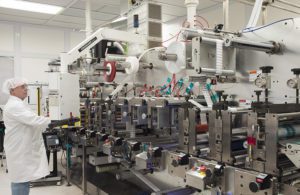Early engagement and close partnerships between medical device developers or OEMs, contract manufacturing organizations (CMOs) and suppliers can reduce delays to the market, decrease costs and prevent common roadblocks.
Claudio Hanna, Web Industries

(Image courtesy of Web Industries)
Getting a medical device from concept to market takes a significant amount of time and money. Supply delays, unforeseen costs and production challenges can all make the path to commercialization daunting. How can these challenges and delays be avoided? The answer is simple: proactive and effective collaboration. By engaging with trusted partners early in the product design, developers can avoid material and manufacturing challenges that can create delays and impact costs.
The importance of design for manufacturability
Developing a medical device is a complicated endeavor that involves a network of suppliers, different types of materials, reagents and other parts. At the development stage, the goal is just to get the device to work, but the component selections made during this stage can have huge implications on cost and manufacturability. Raw materials and components are typically selected based on performance, but there is also a need to consider other important design for manufacturability (DFM) factors such as quality, availability and scalability.
When a developer or OEM approaches a contract manufacturer, the DFM factors are the first thing that the manufacturer should consider. They need to understand the format that the material is available in and whether that format can easily be integrated into the production process. They will need to evaluate material width, roll length, core sizes and tensile strengths to better understand the material’s limitations. Variations in material quality can increase scrap, limit run rates, create production delays and possibly decrease the quality of the medical device itself. By collaborating with a CMO and materials suppliers during the design phase, developers can eliminate material and manufacturing challenges that may affect the manufacturing process while still being able to optimize device performance.
It’s crucial to leverage collaboration partners’ resources to make the device design successful through to commercialization. This will allow the CMO and suppliers to plan for their responsibilities in getting a device to market. If the product requires new equipment or modifications to the manufacturing process, this will be discovered well in advance. Instead of looking for a “turn-key” solution at the end of the road, use the CMO and materials suppliers to help create the right solution from the beginning.
Effective collaboration
When choosing a collaboration partner, consider their record of accomplishment and references. Try to get a sense for the company’s place in the market, who they do business with, how long they’ve been in the industry and if there are any violations or complaints in their history.
Another consideration is the company’s willingness to show their operation. Can you readily visit their facilities? Are they willing to undergo regular audits? This can indicate their openness and commitment to collaboration, help you determine how the company will manufacture a safe and effective device and how they will overcome problems along the way. They should be willing to discuss their process and manufacturing controls and their quality assurance strategies. Their answers should instill a sense of confidence in their ability to successfully manufacture the devices and manage the supply chain.
Remember: Trust trumps all
The ideas of “trust” or “trustworthiness” can seem like a soft skill or capability – something nice to have but hard to quantify alongside more tangible metrics such as cost, quality and delivery time. However, without trust, there is no effective collaboration. Trust can be earned through clearly defined needs, transparency, and honest communication.
The earlier in development collaboration begins, the more defined each partner’s expectations and scope of work. Planning is everything in the life cycle of a medical device. Without proactive thinking and time considerations, delays and costs are bound to increase. Every company has weaknesses, and every product will encounter challenges. Good partners are willing to communicate those weaknesses or shortcomings in their capabilities and provide strategies to overcome them, and the best partners will always find ways to help each other succeed.
Claudio Hanna is business development director for Web Industries, a specialist in outsourced flexible material converting and end-product contract manufacturing.
The opinions expressed in this blog post are the author’s only and do not necessarily reflect those of Medical Design and Outsourcing or its employees.




